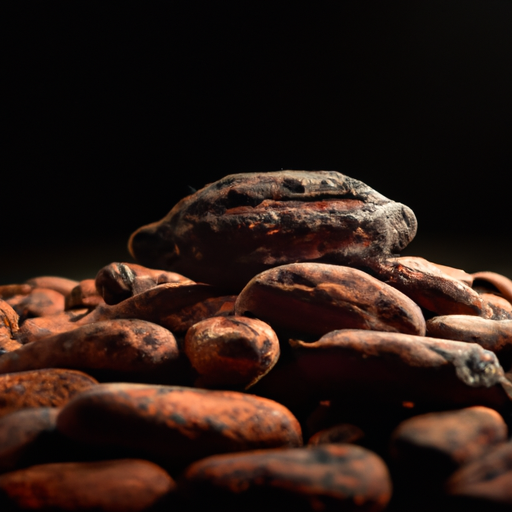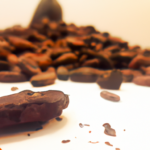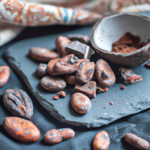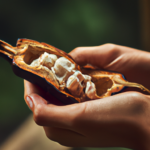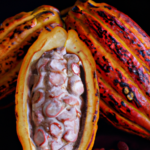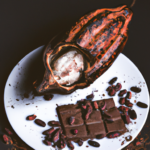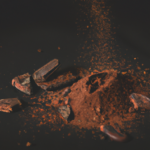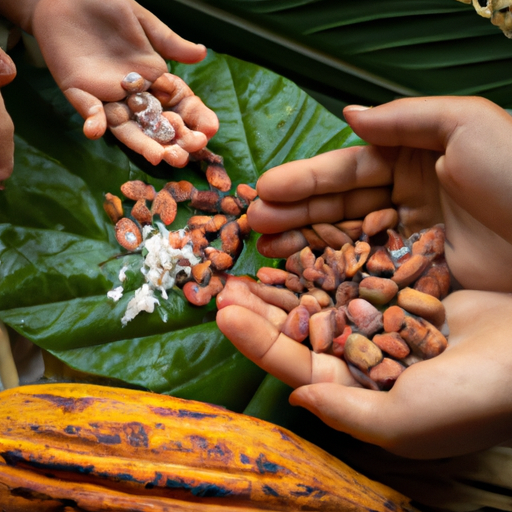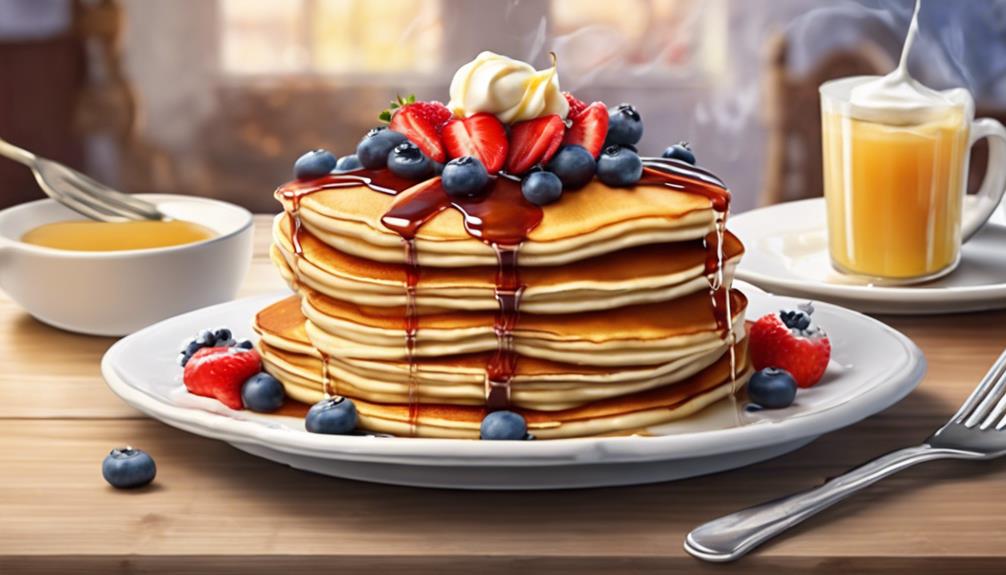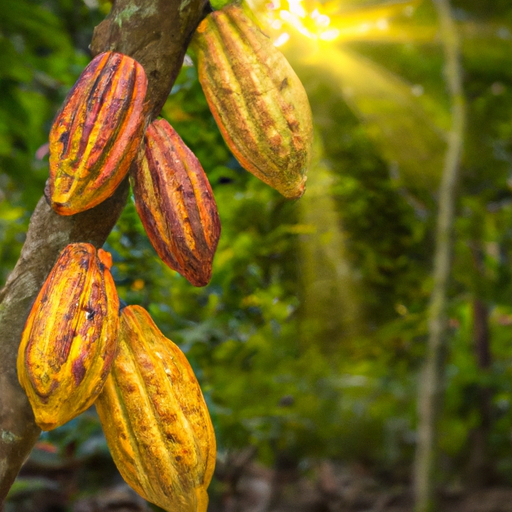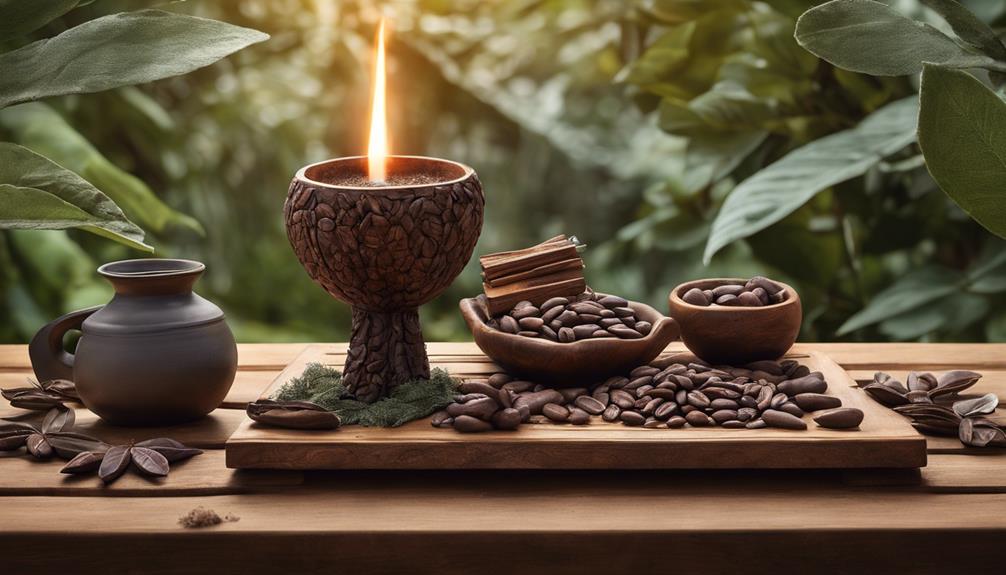They say, “The nose is never wrong.” When it comes to raw cacao, the aroma is truly captivating. I have immersed myself in the realm of chocolate, investigating its beginnings, production techniques, and, naturally, its aromatic qualities. Join me on a sensory adventure in this article as we uncover the delightful scents released by raw cacao.
Unlike its processed counterpart, raw cacao boasts a complex and rich fragrance that can transport you to tropical rainforests and ancient civilizations. From earthy undertones to hints of fruit and floral notes, the scent of raw cacao is a symphony of aromas that tickle the olfactory senses.
But why does scent matter in chocolate making? How does terroir influence the aroma of cacao? And what techniques are used to evaluate its scent? Join me as we dive into the world of raw cacao and discover the captivating scents that accompany this delectable ingredient in our everyday lives.
Key Takeaways
- Raw cacao has a complex and rich fragrance with earthy undertones and hints of fruit and floral notes.
- The scent of raw cacao is distinct, vibrant, and transports to lush rainforests, with elements of rich soil, deep bitterness, and subtle sweetness.
- Processing methods such as fermentation and roasting significantly impact the aroma of cacao, while different cacao varieties and regional variations contribute to its diversity and complexity.
- Raw cacao scent has therapeutic benefits and can be incorporated into daily life through aromatherapy, skincare products, candles, and chocolate-making.
The Origins of Raw Cacao
When you bite into a piece of raw cacao, the rich aroma immediately transports you to the lush forests where it originated. Exploring cacao origins reveals its historical and cultural significance.
Native to the tropical regions of Central and South America, cacao has been cultivated and consumed for thousands of years. It was highly valued by ancient civilizations such as the Mayans and Aztecs, who believed it possessed divine properties.
The cacao tree, Theobroma cacao, thrives in the humid climates of these regions, where its delicate flowers give way to cacao pods that contain the precious seeds. These seeds are carefully fermented, dried, and processed to create the raw cacao we know today.
Understanding the historical and cultural context of cacao origins provides a deeper appreciation for the scent profile of raw cacao.
The Scent Profile of Raw Cacao
When exploring the scent profile of raw cacao, one cannot ignore the prominent aromatic notes of earthiness and bitterness. These notes give raw cacao its distinct and rich character, evoking images of fertile soil and deep-rooted plants.
However, amidst the earthy tones, there are also hints of fruitiness that add a touch of sweetness to the overall scent.
Additionally, one may detect subtle floral undertones, lending a delicate and fragrant quality to the aroma of raw cacao.
Aromatic notes of earthiness and bitterness
With its aromatic notes of earthiness and bitterness, raw cacao envelops the senses in a captivating and alluring fragrance. The scent evaluation techniques used to analyze the aroma of raw cacao reveal its distinct characteristics. When inhaling this enticing aroma, one can detect the following elements:
-
Rich soil: The earthy scent of raw cacao transports me to a lush rainforest, where the cacao beans are grown. It is as if I can smell the fertile soil that nourishes these precious beans.
-
Deep bitterness: The strong, bitter aroma of raw cacao hints at the powerful antioxidants and flavonoids present in this natural ingredient. It is a testament to the potential health benefits that can be derived from its scent alone.
-
Subtle sweetness: Amidst the earthiness and bitterness, there is a delicate sweetness that lingers in the air. This hint of sweetness enhances the overall olfactory experience, adding depth and complexity to the fragrance.
As the scent of raw cacao unfolds, it gives way to hints of fruitiness and floral undertones, creating a symphony of aromas that captivate the senses.
Hints of fruitiness and floral undertones
Amidst the captivating fragrance of raw cacao, one can almost taste the lusciousness of ripe fruits and feel the gentle caress of blooming flowers, creating a sensory experience reminiscent of strolling through a vibrant orchard on a warm summer day.
The fruit and floral fragrance of raw cacao is a delightful combination that entices the senses. The aroma of fresh fruits, such as berries and tropical fruits, intertwines with the subtle scent of delicate flowers, giving raw cacao a unique and enchanting character.
As you inhale deeply, the sweetness of the fruits and the delicate undertones of the flowers transport you to a world of pure indulgence. This sensory experience is a testament to the complexity and richness of raw cacao’s fragrance.
Transitioning to the subsequent section about comparing raw cacao to processed cocoa, one can delve deeper into the transformative journey of the cocoa bean.
Comparing Raw Cacao to Processed Cocoa
When comparing the scent of raw cacao to that of processed cocoa, there are noticeable differences. Raw cacao has a rich, earthy aroma with hints of fruit and floral notes.
On the other hand, cocoa powder has a more intense and chocolatey smell, but lacks the complexity and depth found in raw cacao.
This difference in scent can be attributed to the processing methods used to transform raw cacao into cocoa powder, which involves roasting and grinding the beans, altering their natural aroma.
The differences in scent between raw cacao and cocoa powder
The scent of raw cacao is like a rich, earthy chocolate aroma, while cocoa powder has a more processed and slightly bitter smell. To further explore the differences in scent between these two forms of cacao, consider the following:
-
Complexity: Raw cacao offers a complex scent profile with notes of nuttiness, fruitiness, and even floral undertones. Cocoa powder, on the other hand, has a simpler aroma that focuses more on the chocolatey scent.
-
Intensity: Raw cacao has a strong and vibrant scent that can be quite potent. In contrast, cocoa powder has a milder aroma that may not be as pronounced.
-
Freshness: Raw cacao retains its natural freshness, resulting in a more vibrant and aromatic scent. Cocoa powder, being processed, may lose some of its natural aroma during manufacturing.
-
Bitterness: While raw cacao has a pleasant earthiness, cocoa powder can have a slightly bitter smell due to the alkalizing process used to make it.
Understanding these differences in scent between raw cacao and cocoa powder helps us appreciate how processing affects the aroma of cacao and its subsequent uses.
How processing affects the aroma of cacao
Processing cacao alters its aroma, creating a more refined and subdued scent compared to the raw form. The impact of fermentation on cacao aroma is significant. During fermentation, microorganisms break down the sugars in the cacao pulp, generating heat and releasing volatile compounds. This process contributes to the development of complex aromas, including fruity, floral, and earthy notes. However, as cacao undergoes further processing, such as drying and roasting, these volatile compounds become more subdued, giving way to other aroma compounds that are characteristic of chocolate. The role of genetics in cacao scent is also worth exploring. Different cacao varieties possess distinct aromatic profiles, influenced by their genetic makeup. By understanding these factors, chocolate makers can harness the unique aromas of cacao to create exquisite chocolate products. Transitioning to the next section, scent plays a crucial role in chocolate making, influencing the overall flavor and sensory experience.
The Role of Scent in Chocolate Making
To truly appreciate the art of chocolate making, you must first acquaint yourself with the intoxicating aroma of raw cacao. The role of scent in chocolate making is crucial, as it sets the foundation for the delicious flavors that follow. Exploring scent perception and the science of scent and taste allows chocolatiers to create unique and complex flavor profiles.
Here are three key factors that contribute to the aroma of raw cacao:
-
Fermentation: During fermentation, the cacao beans develop distinct fruity and floral notes, adding depth to the overall aroma.
-
Roasting: The roasting process brings out the rich, nutty aromas of cacao, intensifying its fragrance and adding complexity to the final chocolate product.
-
Bean Origin: Different regions produce cacao beans with unique scents, influenced by factors like soil composition and climate.
Understanding the importance of scent in chocolate making is essential for exploring different varieties of raw cacao and creating exquisite chocolates.
Exploring Different Varieties of Raw Cacao
When exploring different varieties of raw cacao, it’s fascinating to discover the unique scents that each bean variety possesses.
The aroma profiles of cacao can vary significantly depending on the region in which it is grown, offering a distinct olfactory experience.
These regional variations contribute to the complexity and diversity of the chocolate-making process, allowing for a wide range of flavors to be explored and appreciated.
The unique scents of different cacao bean varieties
Imagine standing in a room filled with the intoxicating aroma of raw cacao, each bean exuding its own tantalizing scent that beckons you closer. As a sensory evaluator, I’ve had the pleasure of experiencing the unique scents of different cacao bean varieties.
The first subtopic is about regional variations in cacao aroma profiles. When it comes to raw cacao, the aroma can differ depending on where the beans are grown. In Central and South America, you may encounter cacao beans with a fruity and floral fragrance, while African cacao beans tend to have a more earthy and nutty aroma.
These regional variations in cacao aroma profiles add depth and complexity to the overall sensory experience. Moving forward, we will explore the impact of these variations on the final product.
Regional variations in cacao aroma profiles
The unique scents of different cacao bean varieties provide a glimpse into the world of raw cacao aroma. However, it is important to note that the aroma of cacao can also be influenced by the region in which it is grown. This concept, known as terroir influence, highlights the impact of environmental factors on the final product’s sensory evaluation. Regional variations in cacao aroma profiles can be attributed to factors such as climate, soil composition, and altitude. For example, cacao beans grown in the lush rainforests of South America may have a distinct earthy and fruity aroma, while those from the volcanic soils of Africa may exhibit more floral and spicy notes. Exploring these regional differences adds another layer of complexity to the sensory experience of raw cacao. In the subsequent section, we will delve deeper into the influence of terroir on cacao scent.
The Influence of Terroir on Cacao Scent
When it comes to the influence of terroir on cacao scent, it’s fascinating how growing conditions can significantly impact the aroma of the cacao.
The specific climate, altitude, and rainfall of a region all play a role in shaping the unique scent profiles of different cacao varieties.
Additionally, the relationship between soil composition and scent is undeniable. The minerals and nutrients present in the soil can be absorbed by the cacao trees, ultimately contributing to the aromatic compounds found in the beans.
How growing conditions impact cacao aroma
Growing cacao in different conditions impacts its aroma. The influences of weather, such as temperature, humidity, and rainfall, play a crucial role in shaping the unique scent of cacao. A warmer climate intensifies fruity and floral notes, while a cooler climate enhances earthy and nutty characteristics. The amount and timing of rainfall also impact the fermentation process, contributing to the aroma. Cacao growers must understand these factors to create desired flavor profiles. Next, we will explore the relationship between soil composition and scent.
The relationship between soil composition and scent
The incredible impact of soil composition on the scent of cacao is a fascinating topic to explore. The relationship between soil composition and cacao aroma is intricate and profound. Different soil compositions have the power to impart unique flavors and scents to the cacao beans. This is because soil composition affects the availability of nutrients and the retention of water in cacao trees, which in turn influences their growth and development. Moreover, these factors also play a crucial role in determining the chemical compounds present in the beans, ultimately contributing to their scent.
To evaluate the scent of raw cacao, experts employ various techniques such as sensory analysis and gas chromatography. These techniques allow them to identify and quantify the specific aroma compounds present in the beans. By understanding the relationship between soil composition and cacao scent, experts can gain insights into the quality and characteristics of the beans.
In addition to exploring the impact of soil composition on cacao scent, we will also delve into the captivating world of harvesting and roasting techniques. It is during these processes that the true potential of these aromatic beans is unleashed, further enhancing their scent and flavor.
Harvesting and Roasting Techniques
When it comes to the fascinating world of cacao, the impact of roasting on its scent cannot be understated. Roasting is a crucial step in the cacao production process. It enhances the flavor and plays a significant role in developing the aroma. Different approaches to roasting can result in varying effects on the cacao’s fragrance. This makes it an area of great interest and exploration in the world of chocolate-making.
The impact of roasting on cacao scent
The impact of roasting on cacao scent is significant. Roasting plays a crucial role in developing the complex notes and nuances that make chocolate so enticing. When cacao beans are roasted, various chemical reactions occur, resulting in the production of volatile compounds. These compounds contribute to the distinct aroma of roasted cacao, including notes of toasted nuts, caramel, and even hints of fruitiness. Aroma is a paramount factor in chocolate tasting, as it is the first sensory experience that greets your senses and sets the stage for the flavor journey that follows. These aromatic compounds are essential in creating the desired sensory profile of the final chocolate product. In the subsequent section, we will explore different approaches to roasting and their effects on aroma, delving deeper into the fascinating world of cacao scent.
Different approaches to roasting and their effects on aroma
Different approaches to roasting and their effects on aroma can be grouped as follows:
-
Various roasting techniques:
- Different flavor profiles and aromas can be brought out in raw cacao by employing different roasting techniques.
- The duration and temperature of the roast, as well as the type of equipment used, play a crucial role in the final aroma of the cacao.
-
Longer roasting time at a lower temperature:
- This approach may result in a rich and nutty aroma.
-
Shorter roast at a higher temperature:
- This technique can produce a more fruity and floral scent.
These roasting techniques have a significant impact on the aroma compounds present in the cacao, ultimately influencing the overall sensory experience.
With a solid understanding of these techniques, we can now explore the art of cacao scent evaluation and its role in the chocolate-making process.
The Art of Cacao Scent Evaluation
During the process of evaluating cacao scents, one can distinctly perceive the rich aroma of raw cacao. This sensory experience offers valuable insights into the quality and origin of the beans.
-
Terroir Influence: The unique combination of climate, geography, and soil composition plays a crucial role in shaping the scent profile of cacao. Aromas can range from earthy and nutty to fruity and floral, depending on the specific terroir where the cacao is grown.
-
Soil Composition: The minerals, organic matter, and pH levels of the soil directly impact the fragrance of raw cacao. Different soil compositions can contribute distinctive notes, such as hints of minerals, herbs, or even subtle smokiness.
-
Sensory Evaluation: By carefully assessing the cacao scents, experts can identify desirable characteristics, detect any potential defects, and determine the overall quality of the beans.
Transitioning into the subsequent section, the delightful scents of raw cacao in everyday life evoke a sense of indulgence and anticipation.
The Delightful Scents of Raw Cacao in Everyday Life
I love incorporating the delightful scent of raw cacao into my everyday life through aromatherapy. The rich aroma of cacao helps to create a calming and relaxing atmosphere, promoting a sense of well-being.
I also enjoy using cacao-scented products in my daily routine, such as body lotions and candles, to enhance my sensory experience and indulge in the comforting scent of cacao throughout the day.
Using raw cacao scent in aromatherapy
Imagine yourself inhaling the intoxicating scent of raw cacao in aromatherapy, as it transports you to a world filled with sweet indulgence and relaxation. Using raw cacao scent in meditation can enhance the experience, allowing you to delve deeper into a state of calmness and focus. The therapeutic benefits of raw cacao aroma are truly remarkable. It has been known to uplift mood, reduce stress, and promote feelings of well-being. The rich, chocolatey fragrance stimulates the senses, creating a soothing and comforting atmosphere. To fully appreciate the power of raw cacao scent, imagine a 2-column and 3-row table as follows:
| Therapeutic Benefits | Description |
|---|---|
| Uplifts mood | Evokes feelings of happiness and joy |
| Reduces stress | Calms the mind and relaxes the body |
| Promotes well-being | Enhances feelings of contentment and balance |
Incorporating cacao-scented products into your daily routine can add a touch of luxury and relaxation to your life.
Incorporating cacao-scented products into your daily routine
To add a touch of luxury and relaxation to your daily routine, why not incorporate cacao-scented products? These products can transport you to a world of indulgence and serenity. The rich and intoxicating aroma of raw cacao can be incorporated into your daily routine in various ways.
One option is to use cacao-scented candles during your evening relaxation time. As the warm glow of the candle fills the room, the delicious scent of cacao will envelop you, creating a soothing and calming atmosphere.
Another way to incorporate the cacao scent is by including it in your skincare routine. Look for skincare products that contain cacao extract or essential oil. These products can provide numerous benefits for your skin while also leaving behind a subtle and delightful cacao aroma.
So go ahead, indulge in the decadent scent of cacao and elevate your daily routine to a whole new level of luxury and serenity.
Frequently Asked Questions
How is the scent of raw cacao different from that of processed cocoa?
When comparing the aroma profiles of raw cacao and processed cocoa, the scent of raw cacao is more vibrant and complex, with notes of fruity, earthy, and floral aromas. Retaining its fragrance during processing requires careful temperature control and minimizing exposure to oxygen.
Can the scent of raw cacao be used to determine its quality or flavor?
The scent of raw cacao can be used as a quality assessment tool, as it is closely linked to its flavor. The relationship between the aroma and taste of raw cacao allows for a precise evaluation of its overall quality.
Are there any health benefits associated with the scent of raw cacao?
The scent of raw cacao has been associated with various health benefits. Aroma therapy using raw cacao has been shown to promote relaxation, reduce stress, and improve mood, making it a potential holistic remedy.
Are there any specific techniques or tools used to evaluate the scent of raw cacao?
Scent evaluation techniques, such as aroma profiling, are used to assess the smell of raw cacao. These methods involve analyzing the volatile compounds present in the scent, providing a precise and technical assessment of its aromatic characteristics.
Can the scent of raw cacao vary depending on its country of origin or growing conditions?
The scent of raw cacao can vary depending on its country of origin and growing conditions. Scent variations are influenced by factors such as climate, which can impact the aroma profile of the cacao beans.
Does the smell of raw cacao have any impact on its stimulant properties?
The smell of raw cacao has no direct impact on its stimulant benefits. However, the aroma of raw cacao can enhance the overall sensory experience, which may contribute to a sense of well-being and satisfaction, complementing the stimulant properties of raw cacao.
Conclusion
In conclusion, the exploration of raw cacao scent has been a fascinating journey. From its origins to the intricacies of chocolate making, the scent of raw cacao plays a crucial role.
Its distinct aroma, reminiscent of rich earthy notes mixed with hints of fruity undertones, is a delightful sensory experience.
By understanding how terroir and harvesting techniques influence cacao scent, we can appreciate the complexity and uniqueness of different varieties.
So next time you encounter the alluring fragrance of raw cacao, let it transport you to a bygone era, where the sweet aroma fills the air, invoking a sense of nostalgia and wonder.

